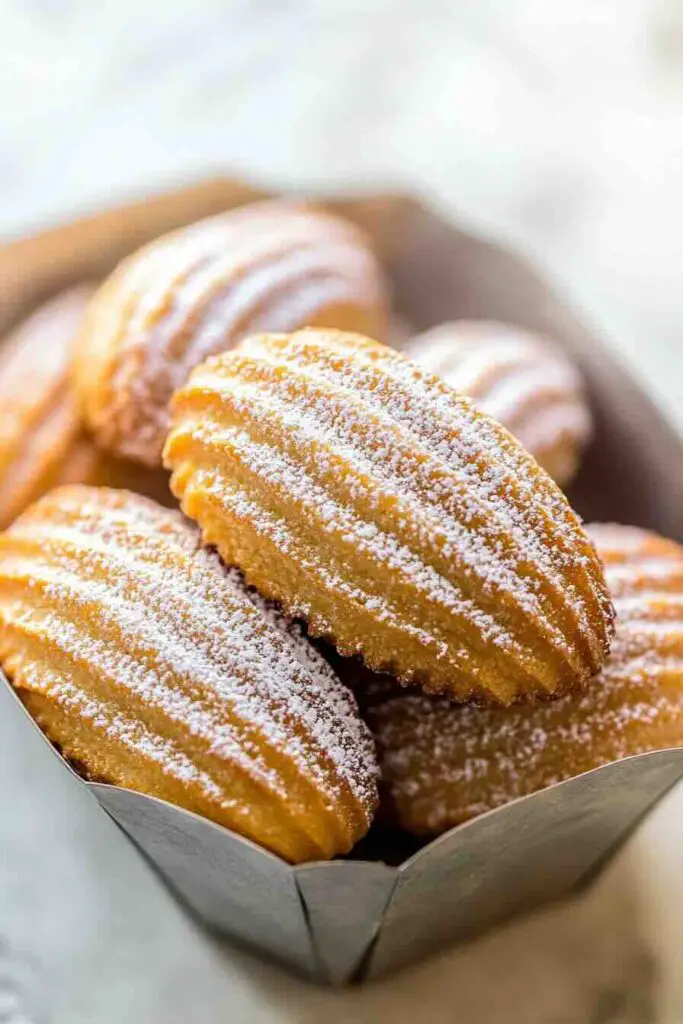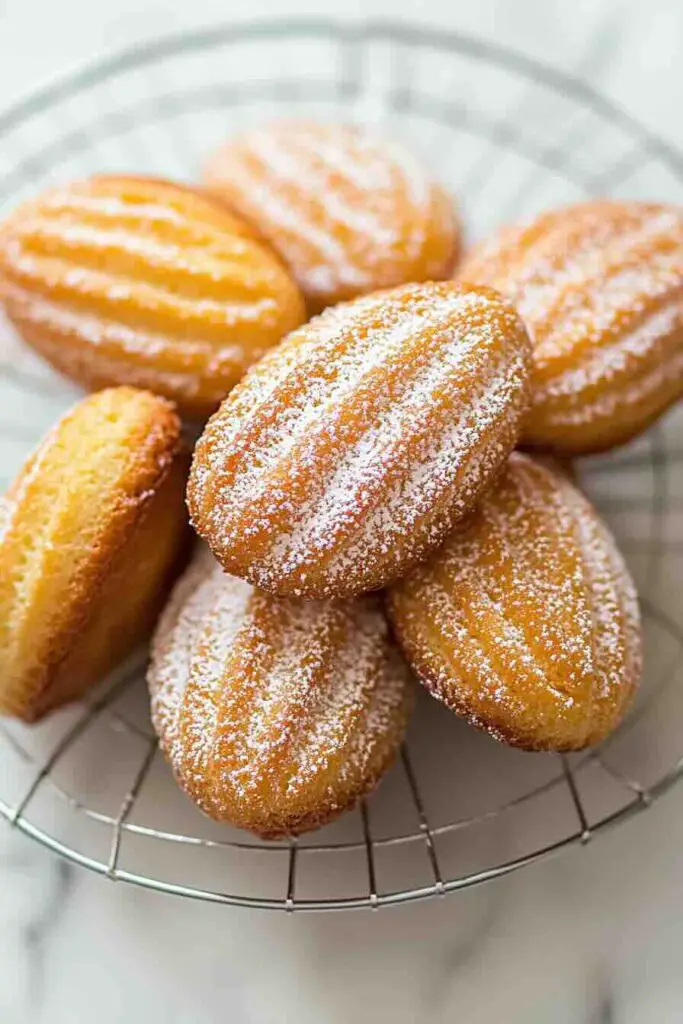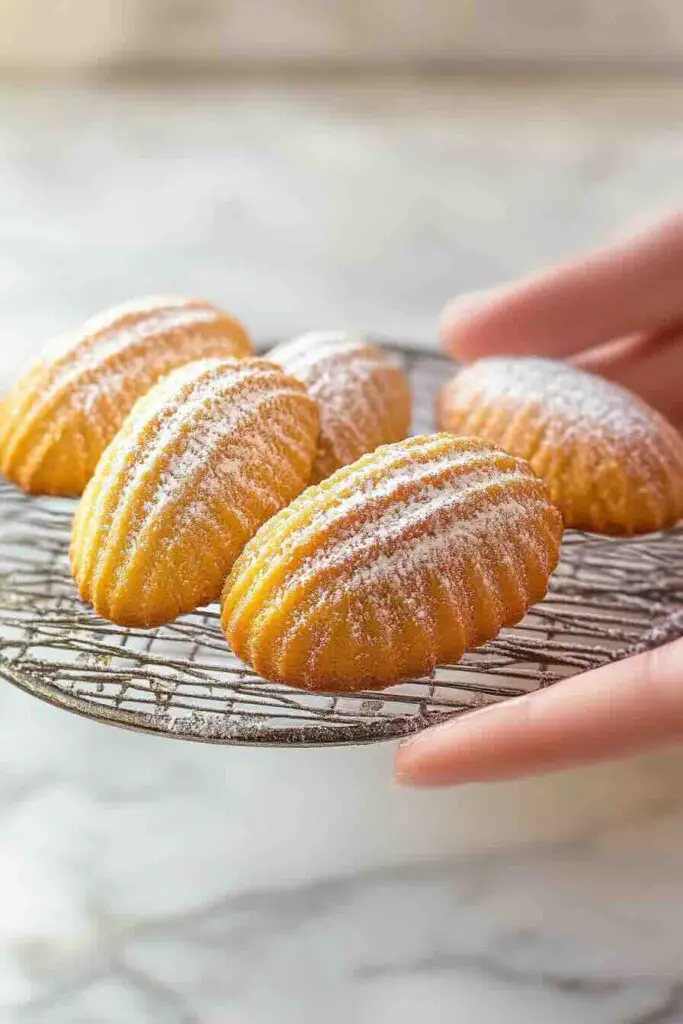Introduction
Ah, the Madeleine! If you’ve never had the pleasure of biting into one, let me paint you a picture: golden, slightly crisp edges giving way to a soft, spongy interior, delicately scented with vanilla and citrus. It’s the kind of cake that transports you straight to a quaint French café, where you sip on a piping hot café au lait, watching the world go by.
But what makes this seemingly simple treat so special? And why do people obsess over achieving that perfect little hump on top? Well, you’re about to find out! From its origins to foolproof techniques, we’re covering everything there is to know about Madeleines. So, buckle up, grab a whisk, and let’s get baking!

Why You’ll Love This Madeleine Recipe
There are about a million reasons to fall head over heels for Madeleines, but let’s keep it simple:
- Quick & Easy – These beauties come together in a snap! Minimal ingredients, a straightforward method, and no fancy equipment required.
- Perfect Texture – Soft, buttery, and tender on the inside, with those signature crisp edges. Absolute perfection!
- Make-Ahead Friendly – The batter actually gets better with time. Refrigerate or freeze it, then bake fresh whenever the craving hits.
- Endlessly Versatile – Stick to the classic lemon zest, or go wild with flavors like almond, coconut, or chocolate.
- Pairs Like a Dream – Seriously, there’s no better companion for your morning coffee or afternoon tea.
And if that doesn’t convince you, just wait until your kitchen fills with the sweet aroma of warm, buttery Madeleines. Pure magic!
What Makes a Good Madeleine?
Not all Madeleines are created equal. Some come out too dry, some don’t rise properly, and others lack that signature melt-in-your-mouth texture. So, what separates a flawless Madeleine from an average one?
- A Fine, Delicate Crumb – These aren’t dense cakes; they should be light, airy, and oh-so-tender.
- Soft Yet Crisp Edges – That slight crunch as you take a bite? Absolutely essential.
- The Iconic Dome – The famous “hump” isn’t just for looks—it’s a sign that your batter was properly rested and your oven was the right temperature.
- A Buttery, Melt-in-Your-Mouth Feel – Rich but never greasy, light but never dry. Balance is key!
- Golden Brown Goodness – A perfect Madeleine has a lightly golden top and a deep golden hue underneath.
- A Hint of Citrus – The bright zing of lemon zest brings everything together without overpowering the buttery notes.
Mastering these elements will take your Madeleines from “pretty good” to chef’s kiss perfection.
The Cultural Significance of Madeleines
Oh, Madeleines aren’t just another pastry—they’re a cultural icon!
- A True Symbol of French Baking – Just like croissants and macarons, Madeleines are a staple of French pastry culture.
- Tea-Time Royalty – In France, these little cakes are often served with tea, coffee, or even a light dessert wine.
- A Literary Darling – Thanks to Marcel Proust’s In Search of Lost Time, Madeleines became forever linked with nostalgia and memory.
- A Taste of Childhood – Many French people have fond memories of eating freshly baked Madeleines as kids—dipped into milk, of course!
- Worldwide Appeal – Once a French delicacy, now a global favorite! From bakeries in Tokyo to cafés in New York, you’ll find these shell-shaped delights just about everywhere.
Simply put, Madeleines are more than just a treat—they’re a tradition.
A Brief History of Madeleines
Like all good things in life, Madeleines have a bit of mystery behind them.
- Lorraine, France – The Birthplace – The most popular story credits a young maid named Madeleine Paulmier, who baked these little cakes for the Duke of Lorraine. He loved them so much, he named them after her!
- 18th-Century Popularity Boom – From royal courts to village bakeries, Madeleines quickly spread across France.
- A Staple in French Patisseries – By the 19th century, nearly every French pastry shop had Madeleines on display.
- Traditional vs. Modern Twists – While lemon and vanilla remain the classics, today’s variations include matcha, rose, and even saffron-infused Madeleines!
From humble beginnings to global fame—what a journey for such a tiny cake!
The Essential Ingredients for Perfect Madeleines
When it comes to baking, every ingredient has a purpose. Here’s what you’ll need:
- Flour – Plain or all-purpose works best for structure.
- Baking Powder – The secret to that light, fluffy interior.
- Eggs – Room temperature is a must for smooth mixing!
- Sugar – Caster sugar dissolves beautifully, giving the cake a fine texture.
- Butter – Melted and slightly cooled—this is what gives Madeleines their signature richness.
- Honey – A little touch of honey adds moisture and a subtle sweetness.
- Vanilla Extract – Enhances depth and rounds out the flavors.
- Lemon Zest – Classic, fresh, and utterly irresistible.
- Salt – Just a pinch to enhance all the flavors.
Simple, but when done right? Absolutely divine.
Must-Have Equipment for Baking Madeleine
Great Madeleines don’t require fancy gadgets, but a few key tools make a world of difference:
- A Madeleine Pan – No pan, no Madeleines. That shell shape is non-negotiable!
- Mixing Bowls – For easy ingredient prep.
- A Whisk or Hand Mixer – Whipping air into the eggs and sugar is crucial.
- A Fine Mesh Sifter – To aerate the dry ingredients and prevent lumps.
- A Piping Bag (Optional) – Helps fill the molds evenly without mess.
- A Cooling Rack – Because overcooking is the enemy of a perfect Madeleine.
Got your tools? Awesome—let’s bake!
How to Make Perfect Madeleine
Step 1: Prepare the Batter
- Sift together the flour and baking powder.
- In another bowl, whisk eggs and sugar until pale and foamy.
- Gently fold in the flour mixture, stirring just enough to combine.
- Add salt, honey, vanilla, and lemon zest.
- Finally, fold in melted butter—don’t overmix!
- Cover and chill the batter overnight (trust me, this is essential for the best texture!).
Step 2: Baking the Madeleines
- Preheat your oven to 200°C (390°F).
- Lightly grease the Madeleine pan.
- Spoon or pipe the batter into the molds—don’t overfill!
- Bake for 10 minutes, or until puffed and golden.
- Unmold immediately and serve warm.
And voilà! Fresh, homemade Madeleines that’ll make you feel like a pastry chef in Paris.

Variations & Toppings
Madeleines may be best known in their classic lemon-scented form, but trust me when I say—there’s a whole world of delicious possibilities beyond the traditional recipe! Whether you’re in the mood for a nutty twist, a chocolatey indulgence, or a tropical surprise, these variations will take your Madeleines to the next level. Plus, the right topping can add texture, flavor, and a touch of visual appeal. So, let’s explore some fun and creative ways to customize these little French cakes!
Classic Lemon Madeleines
If you’re a purist, stick to the tried-and-true: fragrant lemon zest folded into the batter for a light, citrusy aroma that balances beautifully with the richness of the butter. For an extra punch, try brushing the warm Madeleines with a simple lemon syrup made of freshly squeezed lemon juice and sugar. This not only enhances the flavor but keeps them irresistibly moist!
Chocolate-Dipped Madeleines
Few things make a buttery sponge cake even better—but dipping it in chocolate? Absolute heaven! Once your Madeleines have cooled, dunk half of each one into melted dark, milk, or even white chocolate. Let the excess drip off, then place them on a wire rack to set. For extra flair, sprinkle with crushed nuts, sea salt, or even edible gold flakes before the chocolate hardens.
Almond-Flavored Madeleines
For a delicate, nutty variation, swap out a small portion of the flour for finely ground almonds. This gives the Madeleines a slightly denser texture with an aromatic, warm sweetness. To enhance the flavor, add a few drops of almond extract alongside the vanilla. You can also sprinkle sliced almonds on top before baking for an elegant, toasted finish.
Coconut Madeleines
Want a tropical spin? Add shredded coconut to the batter or roll the finished Madeleines in toasted coconut flakes after dipping them in white chocolate. You can even replace the lemon zest with lime zest for a brighter, more vibrant taste. These are especially delightful when served with a coconut-infused glaze!
With so many ways to dress them up, you’ll never get bored of these delightful little cakes!
Nutritional Insights About Madeleine
While Madeleines might look dainty and innocent, don’t be fooled—they pack a deliciously rich and buttery punch. That being said, they’re not the worst indulgence out there, especially compared to heavier pastries and desserts. So, let’s break down their nutritional profile and see how they fit into a balanced diet.
Caloric Content
A single classic Madeleine typically contains around 82–100 calories, depending on the exact ingredients used. Since they’re small, they offer a little sweet fix without going overboard, making them a great option when you just want a bite of something indulgent.
Macronutrient Breakdown
- Carbohydrates – The main source of energy here, primarily from flour and sugar.
- Fats – Butter contributes most of the fat content, providing that melt-in-your-mouth texture.
- Protein – While not high in protein, eggs add structure and contribute to the cake’s lightness.
Dietary Considerations
- Contains Dairy & Gluten – If you have dietary restrictions, note that Madeleines contain both butter and wheat flour. However, gluten-free versions can be made using almond or oat flour.
- Lower in Sugar than Other Pastries – Unlike frosted cupcakes or syrup-soaked pastries, Madeleines have a relatively moderate sugar content.
If you’re looking for a slightly healthier option, you can experiment with reducing sugar, swapping in whole wheat flour, or using alternative sweeteners like honey or maple syrup. But let’s be real—Madeleines are meant to be a treat, so enjoy them as they are!
Pro Tips & Tricks
Ah, the difference between an okay Madeleine and an oh-my-gosh-this-is-incredible Madeleine? It all comes down to a few key tricks. Even though these little cakes are simple to make, a little technique goes a long way. Follow these pro tips, and you’ll be baking bakery-worthy Madeleines in no time!
Chill the Batter Overnight
This is the secret to getting that signature hump! Refrigerating the batter allows the gluten to relax, the flavors to meld, and the texture to improve. Plus, when the cold batter hits the hot oven, it creates the perfect contrast for that beautiful rise.
Use a Hot Oven
A high oven temperature (around 200°C / 390°F) is crucial for a good lift. If your oven is too cool, the cakes may turn out flat. If you’re unsure about your oven’s accuracy, use an oven thermometer to double-check.
Don’t Overmix the Batter
Overmixing can develop too much gluten, making your Madeleines tough instead of tender. Once the dry ingredients are added, mix just until combined—no more, no less.
Grease the Pan Well
Even if you’re using a non-stick Madeleine pan, always grease it lightly with butter or non-stick spray. For extra insurance, dust with a bit of flour and tap out the excess. This ensures the cakes pop right out without breaking.
Fill the Molds Properly
You don’t need to spread the batter out—just spoon or pipe it into the molds and let it naturally settle. Overfilling can lead to misshapen cakes, while underfilling won’t give you that lovely dome. Aim for about ¾ full.
Unmold Immediately
The moment your Madeleines are done baking, remove them from the pan and transfer them to a wire rack. Letting them sit in the pan can lead to overcooking from residual heat.
Master these little details, and your Madeleines will be chef’s kiss every time!
Storage & Health Tips
Madeleines are best when fresh, but that doesn’t mean they can’t be stored for later. If you’ve made a big batch or want to keep some on hand for future cravings, here’s how to store them properly.
Best Fresh
Let’s be real—nothing beats a warm Madeleine fresh out of the oven! The texture is at its peak when they’re still slightly crisp on the edges and soft inside.
Storing in an Airtight Container
If you need to store them, place them in an airtight container at room temperature for up to 3 days. Keep them in a cool, dry place to prevent them from getting stale too quickly.
Freezing the Batter
Want to enjoy freshly baked Madeleines anytime? Freeze the batter! Simply portion it into a freezer-safe container, and it’ll stay good for up to 2 months. When ready to bake, just scoop the batter into the molds and bake—no need to thaw!
Reheating for the Best Texture
If your Madeleines have lost their crispness, pop them in a preheated oven at 160°C (320°F) for 3–5 minutes to revive them. Avoid microwaving, as it can make them rubbery.

FAQs About Madeleines
Why Are They Called Madeleines?
Legend has it that a maid named Madeleine Paulmier baked these cakes for the Duke of Lorraine in the 18th century. He was so smitten with them that he named them after her!
Can I Make Madeleines Without a Madeleine Pan?
Technically, yes—you can use muffin tins, but you won’t get the classic shell shape or crisp edges. If you’re serious about making them right, invest in a proper Madeleine pan!
What’s the Best Way to Flavor Madeleines?
Lemon zest is the classic choice, but you can experiment with orange zest, almond extract, vanilla bean, matcha powder, or even espresso!
Are Madeleines Cookies or Cakes?
Despite their small size, Madeleines are definitely cakes. Their texture is light and spongy, similar to a genoise sponge cake.
Before You Go…
Craving more goodness? Check out my recipe for Chocolate Muffins next. It’s just as comforting, indulgent, and easy to make. You’re going to love it! ❤️
Print
Madeleine Recipe
- Prep Time: 10 minutes
- Cook Time: 10 minutes
- Total Time: 1 hour 20 minutes ( 1 Hour Of Chilling Time )
- Yield: 12 1x
Description
These classic French Madeleines are soft, buttery, and delicately flavored with vanilla and lemon zest. With their signature shell shape and golden crust, they’re perfect for afternoon tea or a light dessert. This foolproof recipe ensures a tender crumb and a beautiful hump every time!
Ingredients
Dry Ingredients
- 1 cup (120g) all-purpose flour
- 1 teaspoon baking powder
- ¼ teaspoon salt
Wet Ingredients
- 2 large eggs (room temperature)
- ½ cup (100g) granulated sugar
- 1 teaspoon vanilla extract
- 1 teaspoon lemon zest (or orange zest)
- 2 tablespoons honey
- ½ cup (115g) unsalted butter, melted and slightly cooled
For Greasing the Pan
- 1 tablespoon butter (melted)
- 1 tablespoon flour (for dusting)
Optional Toppings & Variations
- Powdered sugar (for dusting)
- Melted chocolate (for dipping)
- Sliced almonds or coconut flakes (for texture)
Instructions
Step 1: Prepare the Batter
- In a bowl, sift together the flour, baking powder, and salt. Set aside.
- In another large bowl, whisk the eggs and sugar until pale and foamy (about 2–3 minutes).
- Stir in the vanilla extract, lemon zest, and honey.
- Gradually fold in the dry ingredients, mixing gently to avoid overworking the batter.
- Slowly incorporate the melted butter, stirring until fully combined.
- Cover the bowl with plastic wrap and chill in the refrigerator for at least 1 hour (or overnight for best results).
Step 2: Bake the Madeleines
- Preheat your oven to 200°C (390°F). Grease and lightly flour a Madeleine pan.
- Spoon or pipe the chilled batter into the molds, filling each about ¾ full.
- Bake for 8–10 minutes, or until the edges are golden and the signature hump forms.
- Immediately remove Madeleines from the pan and transfer them to a wire rack to cool.
Step 3: Add Finishing Touches
- Dust with powdered sugar, dip in chocolate, or leave them plain.
- Serve warm with coffee or tea and enjoy!
Notes
- Chilling the batter is key! It helps create the classic Madeleine hump.
- For extra flavor, try using browned butter instead of regular melted butter.
- Store in an airtight container for up to 3 days or freeze the batter for fresh Madeleines anytime.
Nutrition
- Calories: 90
- Sugar: 6g
- Sodium: 45mg
- Fat: 5g
- Saturated Fat: 3g
- Carbohydrates: 10g
- Protein: 2g
- Cholesterol: 30mg
